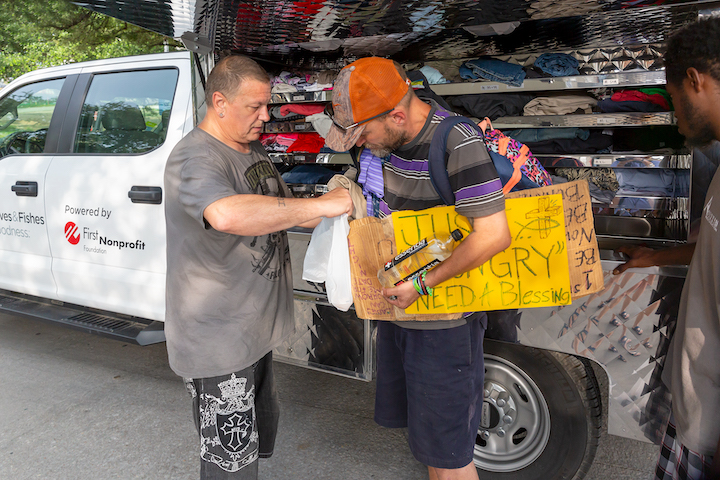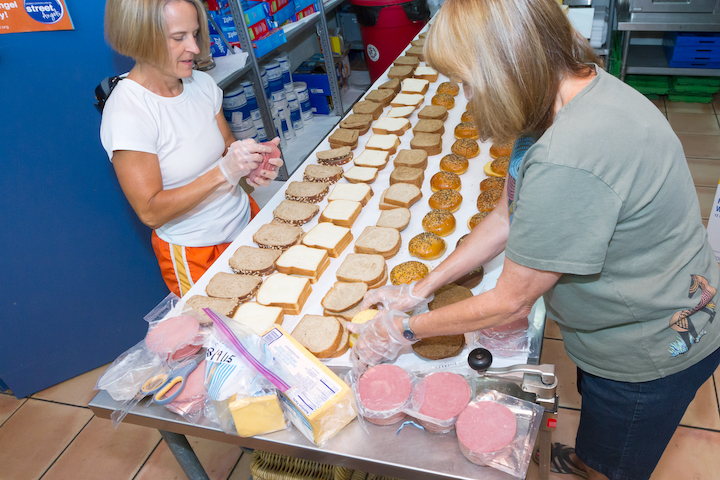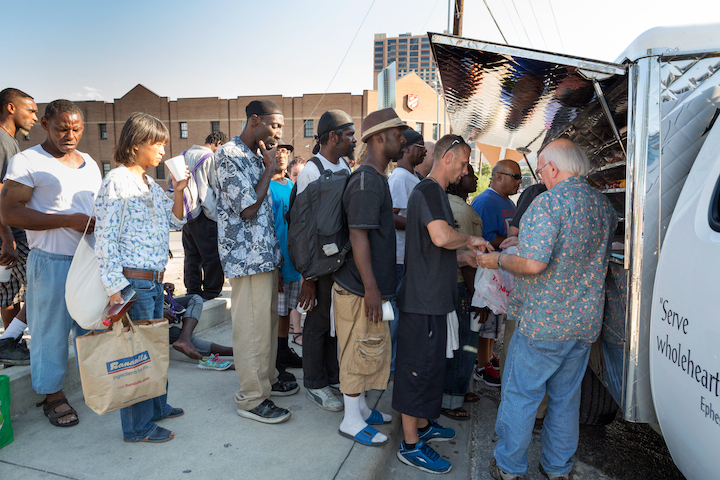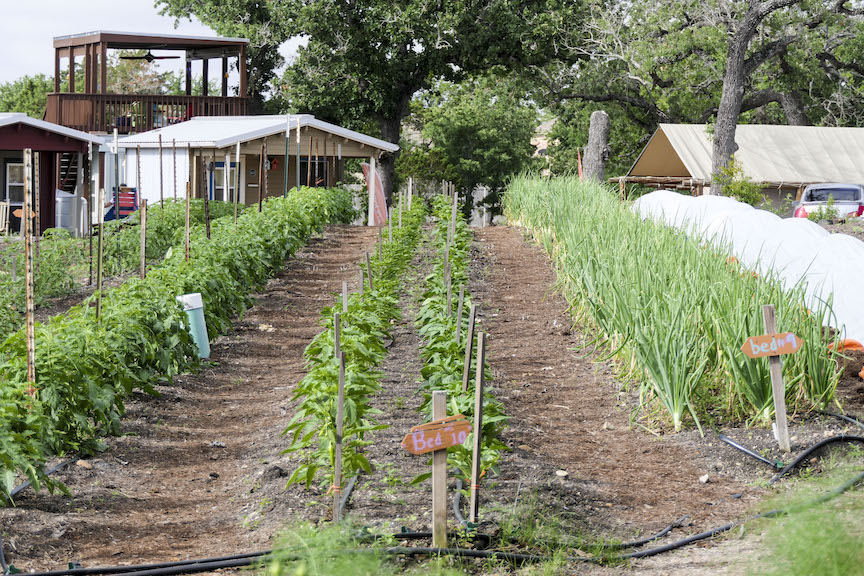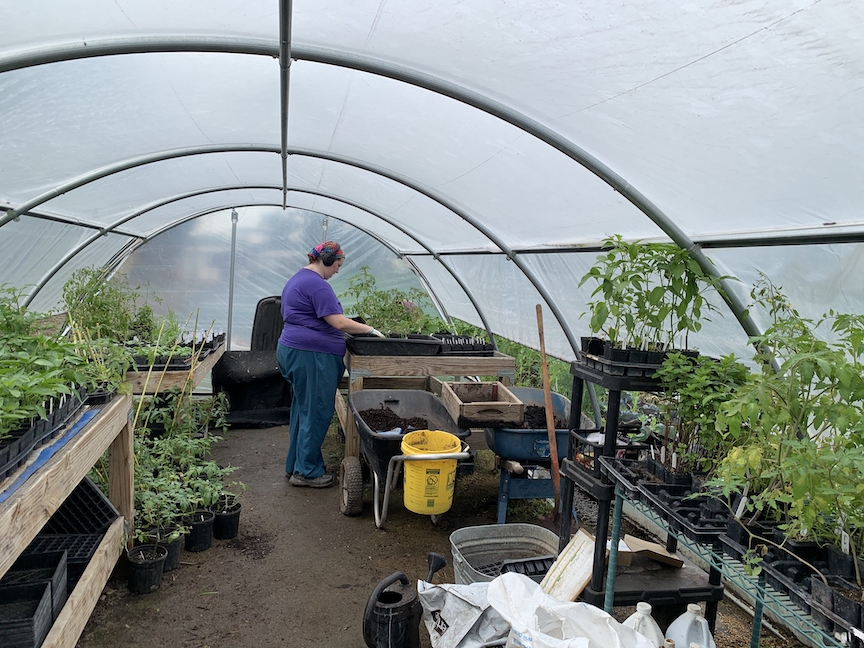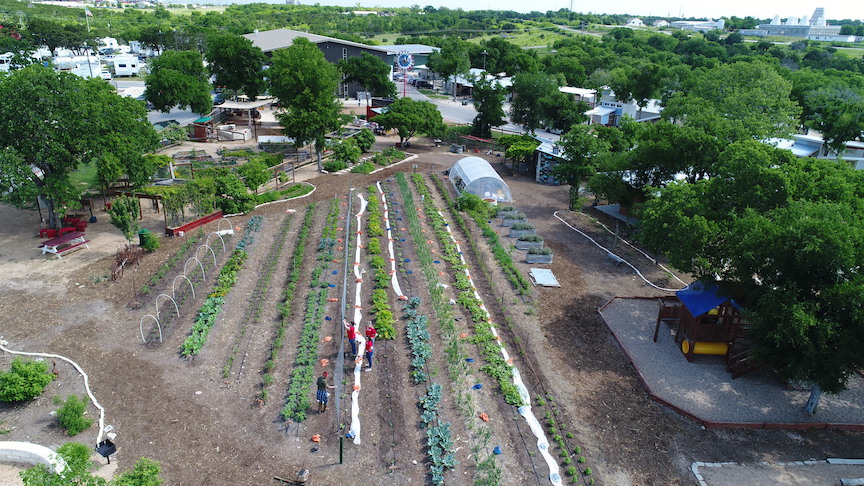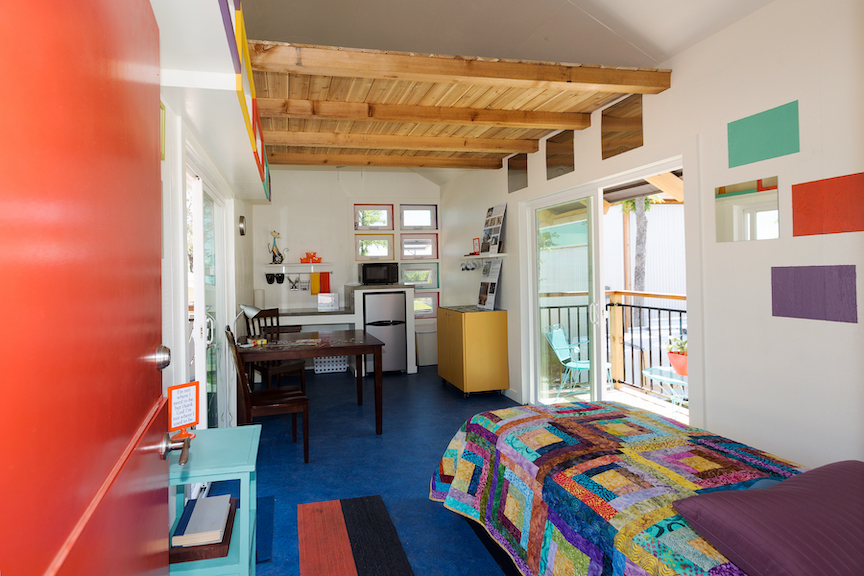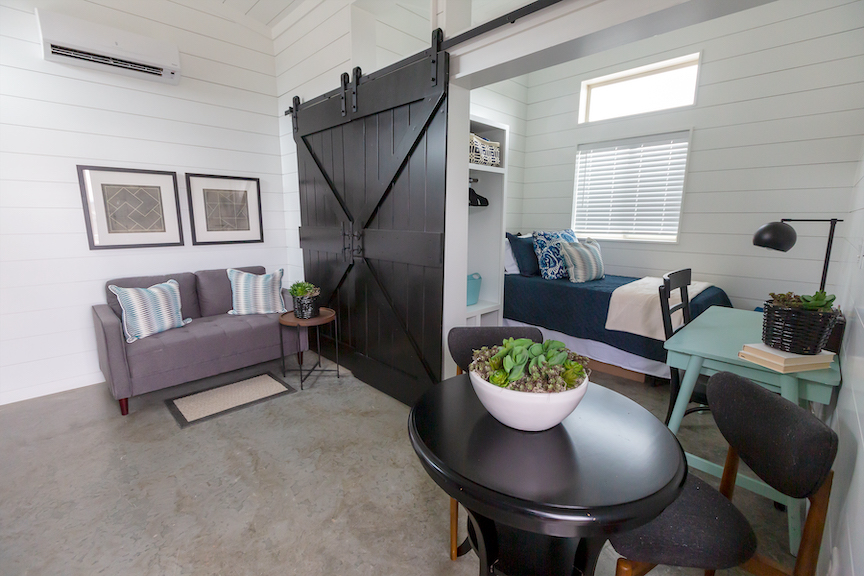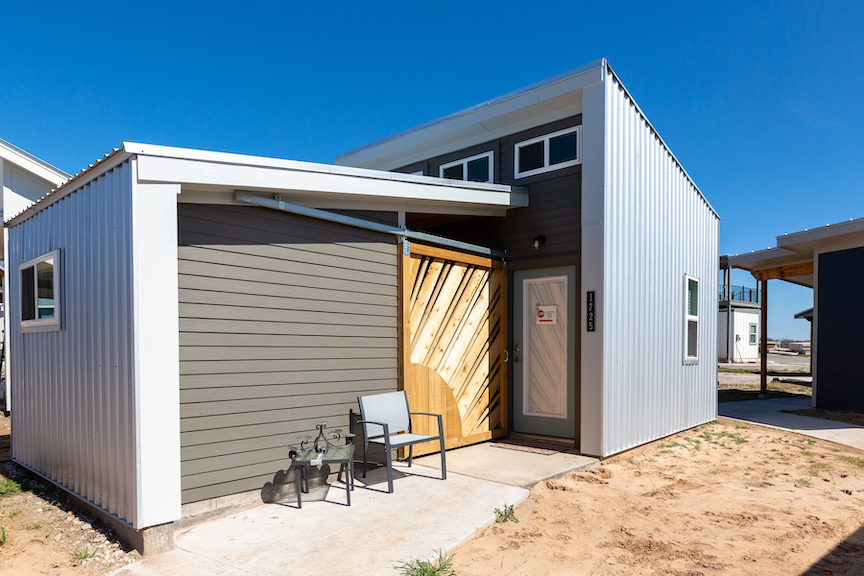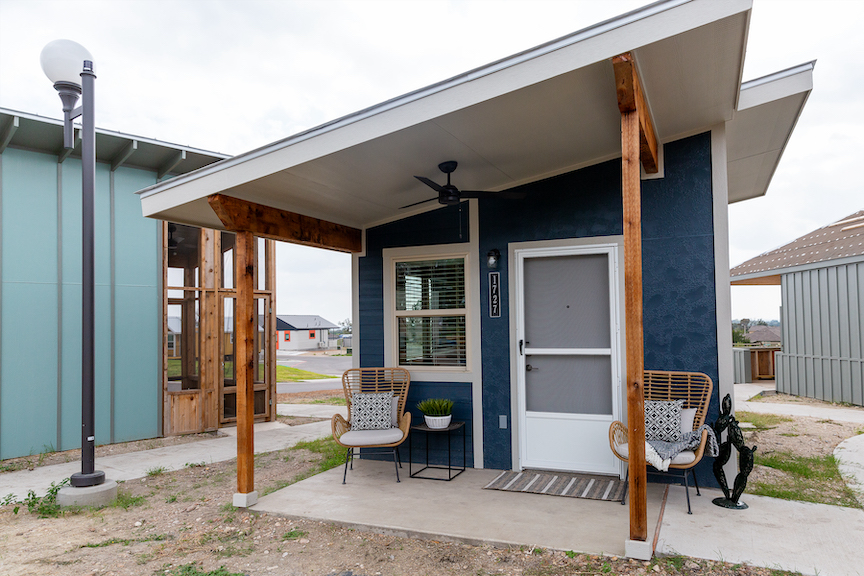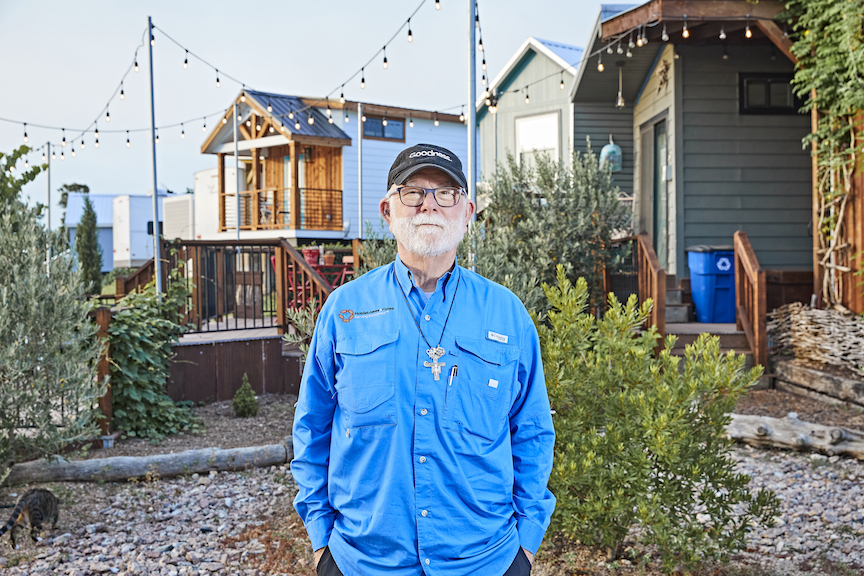
As Alan Graham sees it, “The current system for addressing chronic homelessness in the United States of America is absolutely not working.” In a valiant effort to help remedy the situation, Graham founded Mobile Loaves & Fishes — an Austin-based social outreach ministry that’s grown from a single food truck into a fleet of 12 that’s served 5.5 million meals to homeless individuals since its inception in 1998.
In 2004, the nonprofit purchased its first RV with the goal of “lifting one person off the streets of Austin.” That sole shelter formed the germinating seed for Community First! Village — a 51-acre community in northeast Travis County that provides “affordable, permanent housing and a supportive community for men and women coming out of chronic homelessness.” Originally devised as an “RV park on steroids,” the village evolved into a mix of park model RVs and tiny homes designed by some of Austin’s premier architecture firms — Designtrait, Fazio Architects, Black + Vernooy, Michael Hsu Office of Architecture, Thoughtbarn, Jobe Corral Architects, Chioco Design and McKinney York Architects among them.
Beyond its innovative approach to housing, Community First! Village comprises multiple operations designed to employ residents — including an organic farm, an automotive shop, a cinema, an art house and facilities for forging, woodworking and screen printing. Rightfully, this ambitious undertaking has garnered attention from the likes of CNN, Texas Monthly, People and The Washington Post, among many other media outlets.
Alexander Marchant co-founder Susan Alexander first visited Community First! Village in 2015 to tour the micro homes created as part of Tiny Victories 1.0, a design competition organized by AIA Austin’s DesignVoice committee. “I immediately fell in love with the idea,” Alexander said. “I’m really impressed with the community they’ve been able to build. They support the people that live there in so many ways.”
Alexander was so taken by the endeavor that she started volunteering in the art house at Community First! Village. “I learned a lot from the residents, who were always happy to teach me what they knew about ceramics. I often felt like they were helping me more than I was helping them. … Just being around the artists was great. We would just chat about their lives and experiences. I loved it.”
Although Community First! Village stopped accepting volunteers during COVID, Mobile Loaves & Fishes is “slowly and safely” transitioning into welcoming them back (visit mlf.org/volunteer for details).
As Community First! Village is in the midst of expansion, we reached out to Sarah Satterlee, Director of Architecture & Site Development for Mobile Loaves & Fishes, to learn more about what the future holds for “the most talked-about neighborhood in Austin.”
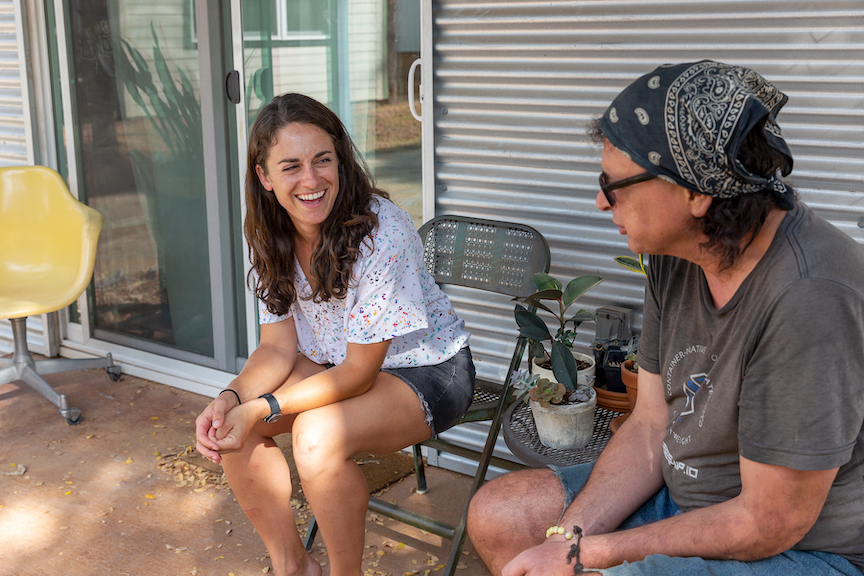
What’s the best way to distinguish Mobile Loaves & Fishes from Community First! Village?
So Mobile Loaves & Fishes is a nonprofit. It’s been around for 23 years now. It was started as a ministry by five friends who were seeing the same people on the street corners every day as they were driving around and just thought, “What can we do?” So they bought an old food truck and they started filling it with clothes and food and that’s how our food truck ministry was born. … But naturally, as we started to meet the same people over and over again, you can’t help but [ask], “What more can we do here besides providing for this very immediate need of food and clothing?” So the organization started putting people up in RV parks all over the city — to varying degrees of success. … At that point the vision was born: “What if we started our own RV park?” And that’s really how the idea for Community First! was born.
And now phase two of the project is nearing completion?
Yes. So we’re building out homes right now and expect to have all of our homes completed by the end of 2022. … It’s 51 acres where we sit right now and that includes phase one and phase two. … It’ll be about 550 units total.
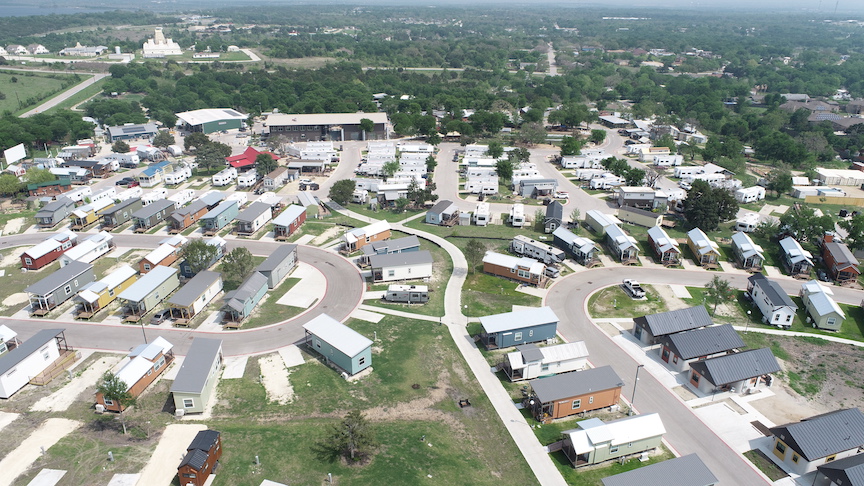
How many different architecture firms and planners were involved in bringing that all to life?
The idea for the village was started as an RV park. … Somewhere along the way, Alan Graham, our founder, got connected to the AIA, and through a pretty mighty effort with a lot of different people involved — including DesignVoice, which is a committee of the AIA — decided to host this design competition that solicited designs from literally all over the world, for micro homes. Our micro homes are site-built, permanent structures that are under 200 square feet of conditioned, livable area. They are not plumbed but they share communal laundry/restroom/shower facilities and outdoor kitchens with the homes that surround them. … I believe we got 50 or 60 entries from all over the place and six were selected. … We have always thought it was very interesting that all the winning entries came from Austin. And we think it’s likely that one of the reasons for that is that during the design process, anybody that was interested in submitting was invited to come out to the village — at that point, it wasn’t a village, it was just a lot of land — for a tour with our founder. And he gave all of these interested parties a tour and really invited them into the heart of what we do. And so we think that probably yielded some more thoughtful designs.
What can you tell me about visiting the facilities or volunteering at Community First! Village?
Our vision statement is to empower communities into a lifestyle of service with the homeless. The lifeblood of what we do is about inviting groups of people into the process of what we’re doing. Because of that we do have things like our amphitheater where we host Friday night movies, our market where people can buy artwork, we host tours all the time, and we typically — in non-COVID times — host several hundred volunteers every week. … And those opportunities are really powerful because your group is typically led by a Community First! neighbor who’s getting paid for the work they’re doing there. So there are lots of different ways for people who do not live at the village to engage and be a part of life at the village.
So COVID has complicated volunteering but is it coming back?
It definitely complicated things. We did kind of put the village on lockdown for most of COVID. That was hard. As I said, that’s kind of the lifeblood of what we do. But our village is actually set up pretty well for a life of social distancing. … So I do feel like it was a happy discovery that we were set up well to accommodate life in a pandemic time. We have slowly started to open back up again. We are now hosting some volunteer groups and we hope to be completely back open by September.
What can you tell us about phase three of the project?
So phase three and four we announced just about a month ago. Phase three is just across the street from our existing property, and that’s an additional 51 acres. And then phase four is on Burleson Road, kind of near the airport, and that’s an additional 76 acres. In total, we’ll have between 1,300 and 1,400 homes on both properties.
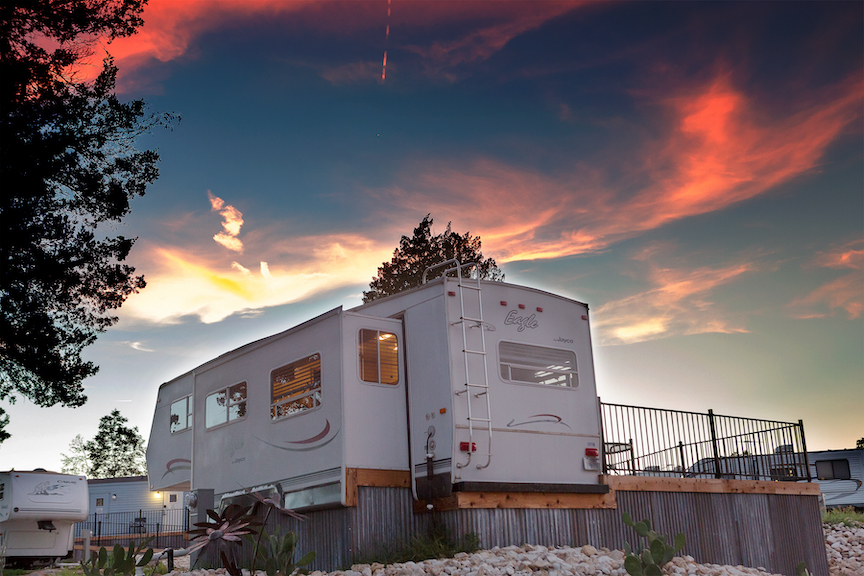
What’s the concept behind “neighborhoods of knowingness”?
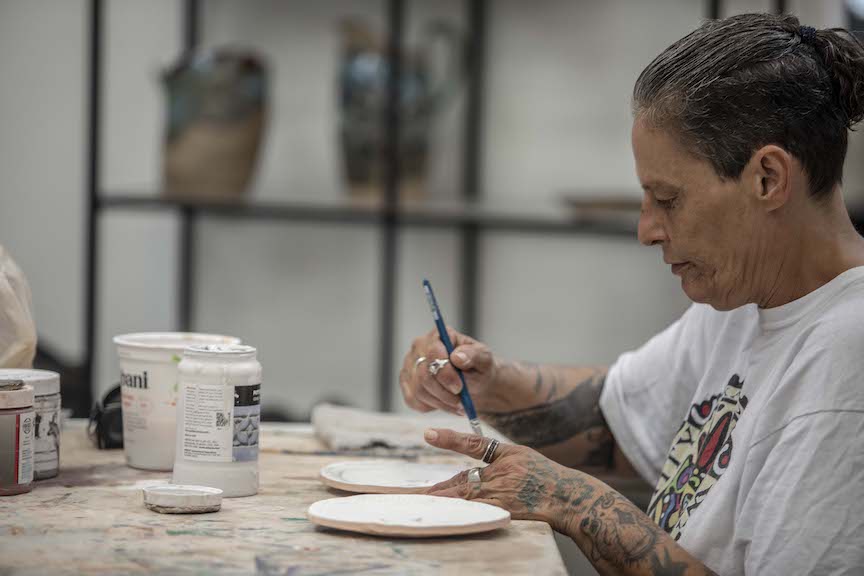
The way that both our phase one and phase two properties are set up right now is that we have one neighborhood of RVs and the other side of the property is a collection of micro homes. And so they’re very much divided into two different groups. And we’ve seen that that introduces a lot of disparities that we would like to intervene with. Our RVs are 400-square-foot units and they’re fully plumbed, they have a kitchen and a bathroom. And typically some of our higher-needs neighbors would be housed in those. They’re more expensive — everybody at the village pays rent. And also 20% of our population is what we call missional — people that may not have experienced homelessness but feel called and have the capacity to live there full-time and serve the neighbors around them. So because of the way that the village is bifurcated down the middle, a lot of our missional neighbors end up living on the RV side, which means there’s not as much of a missional presence in our micro home neighborhoods. And then, occasionally we’ll have neighbors that maybe are living in a micro home but because health conditions have worsened, they require a medical transfer into a unit that might fit their needs a little bit better. But that means that they then get uprooted from their neighborhood and have to move to a different neighborhood. … I believe right now we have 270 residents … But we’re growing right now, we’re moving in 10 people a month on phase two, and eventually we’ll have about 600 people that live in phase one and phase two. So going from 200-ish neighbors to 600-ish neighbors is a big difference. And the question we started asking ourselves as we move from phases one and two to phases three and four is, how do we scale? How do we grow but still keep the thing that makes us work? We know it works at 200 people but how does it work at 1,400 people? And so we decided an innovation that we would like to move forward there is breaking it down into neighborhoods. So that’s where the “neighborhoods of knowingness” came from. The idea behind a neighborhood of knowingness is a collection of about 40 to 50 homes. So we’ll have RVs, we’ll have micro homes, we may end up introducing some new housing types as well. And they would all be centered around a commons area — that’s where communal facilities would be, an outdoor kitchen, green space. So that all sorts of people from different unit types, different walks of life, would be living in the same neighborhood.
Are the same architectural groups involved in these new phases?
So I explained how we integrated architects into phase one. With phase two we actually did something different. We did repeat some of the house sites from phase one in phase two. But before we did that, we worked again with DesignVoice to complete a post-occupancy evaluation of the existing phase one homes [to determine] how well these homes actually serve the needs of the neighbors. That was a really great process. A lot of really amazing volunteers helped make that happen. And from that, we were thinking, how can we innovate further on the houses that we already have? And so instead of casting a wide net to get even more submissions, we kind of wanted to converge a little bit instead of diverge. [We] selected five design/build teams from all over Austin. We asked architects to pair with a builder and submit together and then we paired them with an existing phase one neighbor who was living in the village. We went through a participatory design process with each of those five teams that paired with a neighbor and came out with five new homes based on that process. That was called Tiny Victories 2.0 and [it produced] some really incredible designs. Right now we’re trying to figure out what our design strategy is going to look like for phases three and four. We’re building 200 micro homes for phase two over the course of three years. … On phases three and four we’re going to be building 1,100 micro homes over the course of three years, so that’s a whole other ballgame. One of the things that we’ll be working on, especially as we grow as an organization and really as a campus, we’re going to be looking at how to streamline our design so that we’re really building at an institutional scale, to make the longterm stewardship of our built assets look really beautiful in 20, 30, 40, 50 years. And that’s going to require just a little bit more standardization and thought. … We really, really value good design and partnering with our local design community. And we absolutely want to keep the visual and architectural diversity that really makes the spatial vocabulary of Community First! what it is, as an exciting place people want to come.
